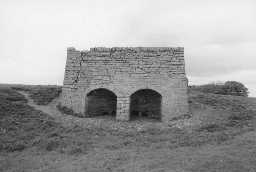Keenley Thorn (West Allen)
Lime kiln (dis). (1)
Grassy bank near large quarry? (2)
Lime kiln in disused quarry, 170m south of Keenley Thorn Farmhouse, Grade II. Probably mid-19th century. Squared rubble with brick. Twin segmental-headed drawing arches, corbelled down to a pair of eyes divided by a brick pilaster, one of each pair has a segmental brick arch, the other a lintel. Coped front wall, ramped down where returns splay out, turn in again to flank charging ramp. Oval pot. Good example of double kiln with charging ramp in limestone quarry. (3)
Fine and well preserved kiln 70m south of Keenley Thorn Farmhouse (not 170m as stated above), and west of road. A mid-19th century double-arched kiln. Rough-coursed, mortared rubble construction. Very largely intact but with some bowing, cracking and collapse in the south west corner. Survives to its complete height of 5m+, with edge-set capstones. In plan 10m wide by less than 20m long, the square kiln giving way to a stone-revetted ramp which curves out and in again in a bellows shape. Ramp may post-date the kiln, as north east wall section is an addition. The two arches are divided by a central stone pilaster. Each is 2m high, with segmental stone arch and corbelled interior, roofed with a single slab. Each arch includes two eyes, divided by a brick pilaster. Of each pair the outer is arched in firebrick, and the inner is rectangular with a stone lintel. The east arch has a poking hole above the eyes, and the east wall includes an inspection hole at 1.5m height. Large oval stone lined pot (5m x 2m, long side parallel to front of kiln) is partly infilled so that the mechanism for directing lime to the four eyes is not visible. Built into a hillside in an area of disused quarries and spoilheaps, some overlain by field walls. (4)
Lime kiln with quarry. (5a)
Marked as a quarry on 2nd edition mapping. (5b)
Grassy bank near large quarry? (2)
Lime kiln in disused quarry, 170m south of Keenley Thorn Farmhouse, Grade II. Probably mid-19th century. Squared rubble with brick. Twin segmental-headed drawing arches, corbelled down to a pair of eyes divided by a brick pilaster, one of each pair has a segmental brick arch, the other a lintel. Coped front wall, ramped down where returns splay out, turn in again to flank charging ramp. Oval pot. Good example of double kiln with charging ramp in limestone quarry. (3)
Fine and well preserved kiln 70m south of Keenley Thorn Farmhouse (not 170m as stated above), and west of road. A mid-19th century double-arched kiln. Rough-coursed, mortared rubble construction. Very largely intact but with some bowing, cracking and collapse in the south west corner. Survives to its complete height of 5m+, with edge-set capstones. In plan 10m wide by less than 20m long, the square kiln giving way to a stone-revetted ramp which curves out and in again in a bellows shape. Ramp may post-date the kiln, as north east wall section is an addition. The two arches are divided by a central stone pilaster. Each is 2m high, with segmental stone arch and corbelled interior, roofed with a single slab. Each arch includes two eyes, divided by a brick pilaster. Of each pair the outer is arched in firebrick, and the inner is rectangular with a stone lintel. The east arch has a poking hole above the eyes, and the east wall includes an inspection hole at 1.5m height. Large oval stone lined pot (5m x 2m, long side parallel to front of kiln) is partly infilled so that the mechanism for directing lime to the four eyes is not visible. Built into a hillside in an area of disused quarries and spoilheaps, some overlain by field walls. (4)
Lime kiln with quarry. (5a)
Marked as a quarry on 2nd edition mapping. (5b)
N6356
FIELD OBSERVATION, North Pennines AONB lime kiln survey 2000; LANCASTER UNIVERSITY ARCHAEOLOGICAL UNIT
FIELD SURVEY, RCHME: North Pennines Industrial Archaeology Project ; RCHME
FIELD SURVEY, RCHME: North Pennines Industrial Archaeology Project ; RCHME
Disclaimer -
Please note that this information has been compiled from a number of different sources. Durham County Council and Northumberland County Council can accept no responsibility for any inaccuracy contained therein. If you wish to use/copy any of the images, please ensure that you read the Copyright information provided.
